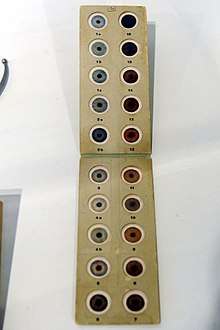Martin scale
The Martin scale is an older version of color scale commonly used in physical anthropology to establish more or less precisely the eye color of an individual; it was created by the anthropologist Martin in the first half of the 20th century. Later he improved this scale with cooperation of Dr. Schulz – the Martin-Schultz scale.

Original scale
The original Martin scale, summarized below, consists of 16 colors (from light blue to dark brown-black) that correspond to the different eye colors observed in nature due to the amount of melanin in the iris. The numbering is reversed in order to match the Martin–Schultz scale, which is still used in biological anthropology. In this case, the higher the number, the lighter the eye color. [1]
Light and light-mixed eyes (16-9)
- 16 : light-blue iris
- 15-14-13 : blue iris
- 12-11 : light-gray iris
- 10-9 : dark-gray iris
Mixed eyes (8-7)
- 8 : green iris
- 7 : green-brown iris
Dark-mixed eyes (6-5)
- 6 : hazel iris
- 5 : light-brown iris
Dark eyes (4-1)
- 4 : brown iris
- 3-2 : dark-brown iris
- 1 : black-brown iris
Older versions
Older versions of the Martin scale eye color chart have the following color divisions:[2][3]
- 16-12 : light and light-mixed iris
- 11-7 : mixed iris
- 6-5 : dark-mixed iris
- 4-1 : dark iris
See also
Notes
- Malinowski A., Bożiłow B., Podstawy antropometrii. Metody, techniki, normy, 1997
- Coon C. S., The races of Europe, 1939
- "Contribution à l'anthropologie des Corses : Anthropologie de la tête (suite) - Persée". persee.fr. 15 October 1968. Retrieved 15 October 2015.